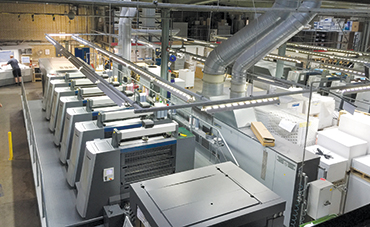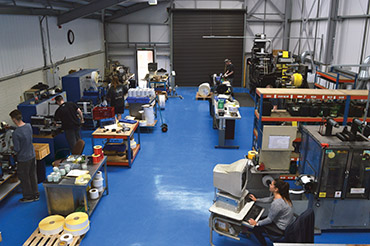However, as the “accessibility and processing power of hardware rapidly improved through the 1990s, so did the sophistication of the software it could run,” adds McMurtrie.
Soon MISs were capable of tackling and automating all manner of different functions including job costing, stock purchasing, production control, reporting and finance. But it wasn’t until the mid-2000s that adoption rates started to rocket.
“Drupa 2004 was named ‘JDF Drupa’ and this is where MIS platforms really kicked off in the industry,” according to Mike Wozny, senior product manager, EFI Inkjet Solutions. “MISs were able to communicate with other key production software platforms such as pre-press. The MIS was then seen as the hub to provide all the key data to production and this was the beginning of workflow automation.”
Take-up of MIS was boosted by the rapid growth of on-demand web-to-print. As a result of the lower run lengths and lower margins per job printers needed to increase efficiencies and over time MISs evolved dramatically to meet the demands of the changing print landscape.
“In the early days of MIS the flavour was very prescriptive and you had a one size fits all approach,” recalls Steve Richardson, sales director at Optimus. “Today, it’s the polar opposite and we’re into a whole different world of order processing where people want maximum information for minimum clicks.”
MIS suppliers are rising to this challenge by continually innovating and developing new iterations of their products that offer greater levels of functionality and meet customer demands.
“Our product development is driven by client requests,” says Alan McKillop, business development manager at Accura. “All responsible MIS vendors should work this way. The print industry is continually evolving and we need to respond and develop what the industry dictates, ensuring clients get the features/modules when they need them.”
The MIS is already the ‘brain’ of printing companies and going forward it will start to take on more and more responsibility within the production workflow, believes McMurtrie.
“Our new layout library tool is a great example of that,” he explains. “After years of trying to deal with imposition changes made at the pre-press stage and the negative impact this has on efficiency and feedback, we shifted the responsibility for this crucial activity backwards, from pre-press to the MIS. Doing this has solved a big problem for the industry; it’s removed a huge barrier to automation.”
In the future Richardson expects to see similar innovative problem solving features introduced as MIS suppliers make systems that are more adept at dealing with the breadth of different tasks that companies want to undertake.
“I see an increasing trend whereby MIS will have to contort and twist itself to meet the flexibility the market is demanding,” he says.
Case study: Micropress
 Located in Reydon, Suffolk, Micropress was founded by Mike Cross in the 1970s. Today, Cross, who still works at the company alongside his two sons James and Rob, employs 170 staff and Micropress generates annual turnover of circa £17m
Located in Reydon, Suffolk, Micropress was founded by Mike Cross in the 1970s. Today, Cross, who still works at the company alongside his two sons James and Rob, employs 170 staff and Micropress generates annual turnover of circa £17m
The commercial printing company specialises in products such as leaflets, brochures, magazines, catalogues and mailers and works for a wide range of different customers spanning small and large businesses, print management companies, publishers and trade work for other printers. For the past 15 years or so Micropress had been using a Shuttleworth MIS and although the system was “perfectly acceptable,” Rob Cross, a director at the company, says the business had grown significantly since its installation.
As a result, “it was becoming more apparent that the system was no longer fit for purpose for a business our size if we wanted to remain a market leader,” he explains. Cross says that the decision to install a new MIS was fast-tracked following EFI’s purchase of Shuttleworth.
“We soon realised that there would be no further investment from EFI in developing Shuttleworth and we needed a system that was keeping up with the fast-paced environment that we work within.”
Micropress looked at a number of different systems and was particularly interested in the MIS packages offered by EFI and one other developer.
“The other MIS was an excellent system and we felt there were areas that were better than EFI Pace, but Pace had the edge due to the automation it can offer our business,” says Cross. “The scheduling is a long way ahead of anything else we looked at – many of the systems are linear whereas the EFI scheduling system is intelligent and will ‘think’ to create the optimum schedule. We also particularly liked the auto-count feature so that each machine is linked back to the MIS giving live data. This gives full traceability of everything we do. You’re also continually collecting data which you can use to report on or just ensure we are on track with workload demands.”
Since the system was installed just over a year ago Cross says the results have been “excellent,” with the company enjoying a number of benefits.
“We are slicker and more efficient within our estimating; our scheduling is more advanced than it has ever been and we have much more warning when we know we are going to have a problem with delivery dates so we are able to react in plenty of time; invoices are with clients a lot quicker and the process is more efficient; our stock control is now automated so we know exactly what stock we are holding and its automatically updated as we print; and we are able to report on productivity, customer conversion rates, sales performance and much more,” he says.
The investment has been a tremendous success for Micropress, although Cross says in hindsight the company would have undertaken more testing before going live with the system and would have created a clear timeline for implementation of each different process.
“If we did it again, we would certainly be smarter on this,” says Cross. “It is important to have the right expectations. We had the foresight to realise this would be an incredibly challenging process so whilst we experienced a lot of pain during the process we were expecting it. I would strongly advise any company looking to change their MIS not to underestimate the complexity of the task and the resource it takes up.”
Case study: Geoff Neal Group
 For years Geoff Neal Group used a DIY MIS, which company managing director Sam Neal says was “pretty good,” but had a number of shortcomings. “We’re currently on the fourth incarnation of our own MIS and it does a great job for us in terms of the estimating and print point of view, but what it doesn’t do is reporting,” explains Neal. “It doesn’t output complete information into the accounts package, for instance, and it can’t speed up or remove the repetitive roles that humans are slower at than computers.”
For years Geoff Neal Group used a DIY MIS, which company managing director Sam Neal says was “pretty good,” but had a number of shortcomings. “We’re currently on the fourth incarnation of our own MIS and it does a great job for us in terms of the estimating and print point of view, but what it doesn’t do is reporting,” explains Neal. “It doesn’t output complete information into the accounts package, for instance, and it can’t speed up or remove the repetitive roles that humans are slower at than computers.”
He says that the company employs some “great people with amazing print knowledge,” but they were spending far too much of their time performing administrative tasks. “What we wanted to do was give time back to every department in the company by implementing an MIS,” adds Neal.
The problem is that despite searching high and low Neal struggled to find a system that met his needs. “From deciding to do this [buy an MIS] to where we are today has probably taken four Drupas – so around 16 years. In that time we’ve written our own program twice,” says Neal.
Another factor that stopped the company committing to an MIS was Neal’s admittance that, at the time, the firm didn’t have the technical skillset to implement one.
“I knew we couldn’t do it ourselves and that it would be the biggest waste of money as we wouldn’t do it properly,” says Neal. “You have to have the right skillset and attitude internally to make it work and get the most from it otherwise it’s a very expensive software buy. Thankfully, we had one guy join us about three and a half years ago who had the skillset and tenacity to make it work.”
Neal says that over the past eight years or so the company has “probably had a demo off every MIS provider out there,” but ultimately he decided to plump for Tharstern.
“We picked Tharstern because we think it’s the best MIS and they are really good at demonstrating their system. They also have a long documented relationship with Heidelberg and we are a Heidelberg house.”
Neal says Tharstern’s package links up with Heidelberg seamlessly, but even if the system didn’t provide the best possible connection to his favoured press manufacturer he would have still bought it as he believes it’s “the most complete MIS system out there today. There will be some MIS suppliers out their saying ‘ours is a bit prettier and faster’ and maybe that’s the truth, but from all the demos and hours that we have spent looking at it and talking to people, Tharstern – when installed and used properly – is the most complete and powerful MIS that you can buy at the moment”.
Installation of the new MIS started in November last year and Neal says the company spent the first three to four months doing a complete re-costing of the business. “The way that we put costs in wasn’t the way that Tharstern wanted the data presented. The Tharstern system is far more analytical and they wanted costs broken down into much more detail, so that you could really drill down into the data. From this initial process we identified a few things that were interesting to know and we identified a few things that were scary to know, but that work was invaluable.”
Members of staff are currently being trained up on the new system and if everything goes to plan Neal hopes it will be fully operational by the end of the year.
“At the moment we’re double estimating using our own system and Tharstern and we’ve already seen some anomalies that the Tharstern system has been able to show us,” he explains. “Getting the costing side right is the first step, then sales, then we’ll start running a few jobs and running jobs alongside. We’ve said we will go live with 80% of everything we do on the new system on the 1 October. Then we’ll do 90%. When we feel completely comfortable we will move everything onto it.”
Case study: Customark
 Greg Lerigo bought printing and labelling company Customark out of liquidation in late 2006. At the time Customark had one site, 26 members of staff and was turning over around £1m. Today, the company operates from four sites – Lye in the West Midlands, Calne in Wiltshire, Cambridge and Oxford – employs 90 people and boasts annual turnover of just shy of £5m.
Greg Lerigo bought printing and labelling company Customark out of liquidation in late 2006. At the time Customark had one site, 26 members of staff and was turning over around £1m. Today, the company operates from four sites – Lye in the West Midlands, Calne in Wiltshire, Cambridge and Oxford – employs 90 people and boasts annual turnover of just shy of £5m.
Lerigo, who is managing director of Customark, says that since he acquired the business its operations have become increasingly more complex, but the systems that were in place were outdated.
“We had a number of different spreadsheets to record information and process orders,” says Lerigo. “It was quite a dysfunctional system that didn’t suit our business needs back then or where we wanted to go in the future. I knew that we needed a fully integrated management system that was a recognised product in the marketplace.”
He looked at a number of different MIS products, but eventually narrowed the choice down to EFI and one other supplier. “I made the decision to go with EFI, but not with the product we have now. We signed up for EFI Gamsys which EFI said was going to be the company’s European-wide product, but while we were in the early stages of starting the data implementation they turned around and said it didn’t work. They then demonstrated a product called Shuttleworth, which I would have bought from the outset had they shown it to me because it was far better suited for what we needed.”
Lerigo says that in November 2016 Customark started the process of building up the data and getting everything ready to go live the following April – EFI supported the company through this. “We went live in the first site in April 2017 at our largest site [Lye] and the first three months were hell,” he recalls.
“The second three months were much better. It probably took about nine months for us to start collecting meaningful data about the business that I could rely on.”
Lerigo says the implementation process was challenging and involved a thorough overhaul of the company’s estimating and commercial thinking. “It took time for this cultural change to be accepted,” he says. Thankfully, when the company rolled the system out to its second largest site in April this year it had already gone through the installation process once so it knew exactly what to expect and relied less on EFI for support.
“We fundamentally redrew some of the estimating parameters at our second site and we’ve now gone back and used quite a bit of the data and parameters on the first site installation,” says Lerigo. “We learned more about the system and our business doing it [the installation] ourselves.”
At the moment the company is holding off installing it at a third site as it’s less critical to the day-to-day running of the site, although Lerigo is hopeful that by April 2019 the MIS will be active across the entire business.
He says that installing the MIS been a “really long, torturous process,” but it’s been worth the pain. “At our main site we are about 15 months or so on from installation and the upshot is that in the first quarter of this year compared to last year I outputted £30,000 more work with fewer people,” says Lerigo. “It’s made us more efficient from an output point of view. The real-time shop floor data capture was also a major shift for the company that was a difficult cultural change to drive through, and become the accepted process, but we are seeing real bottom line benefits.
“It’s made us much more efficient from an integrated data capture point of view. It’s made us much more efficient in being able to post cost and it’s given us a much greater ability to analyse the business and make informed quantitative decisions about what we do.
“We can now make much more measured investment decisions because we can look at what we doing now and compare it to manufacturer’s data on new equipment and see exactly what those machines will give us in terms of makeready time savings, etc. So for me despite the pain it’s been brilliant.”











